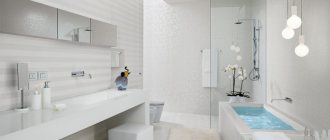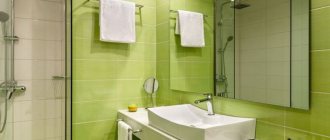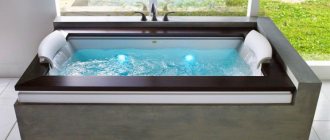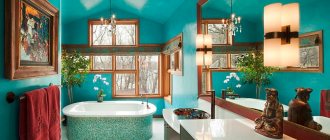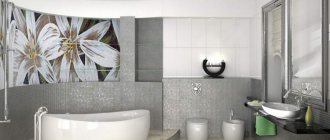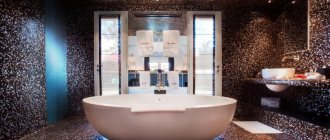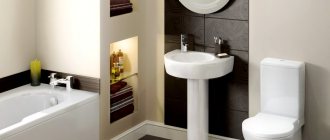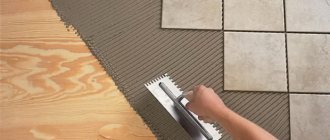To decorate your bathroom space in a modern style, it is better to use tiles with a matte surface rather than glossy ones. It is the matte texture that gives a stylish, calm and fashionable image to the room. Moreover, matte tiles are good not only for walls, they look gorgeous on both the floor and the ceiling. Let's consider in the article what features matte bathroom tiles have and what to look for when choosing them.
Characteristics of matte bath tiles
Matte tiles lack shine; because of this, when selected in a store, they do not look as nice as glossy ones. However, this is only the first impression, as on the wall of the bathroom it becomes truly beautiful and chic.
The number of colors and patterns that are applied to matte tiles make it an even more sophisticated cladding. In addition, there are relief matte tiles, which, thanks to the different shapes of the pattern, create a design that looks expensive. Add frosted glass or a mirror to your bath and complete the style.
Beauty is only one of the benefits of matte tiles. The most important thing is the properties of the rough surface. It does not absorb or allow moisture to pass through, which allows you to preserve the surface even longer than in the case of glossy tiles.
And when covering the floor with this tile, slipping is reduced, which reduces the risk of injury in such a damp room. So, if you still haven’t decided which coating to choose for tiling the walls and floor of the bathroom, then matte tiles are for you. In addition, you can install frosted doors in the bathtub.
Choice
Before you decide to buy matte or glossy ceramics, you will have to understand that ceramic tiles must be of high quality. What else you need to consider when buying tiles for the bathroom:
- tile parameters: the size of each product individually, as well as the shape;
- texture of the material and shade of the tile;
- characteristics of ceramics, as well as performance indicators.
Now let's look at each of these points in more detail. Speaking about tile sizes and shapes, it should be said that, as a rule, tiles have a rectangular or square shape, but there are also exclusive models that are more present in premium collections and can reproduce various geometric shapes (triangular, from tetrahedral to octagonal).
Regarding the sizes, here I would like to say that tiles come from the smallest specimens - 46 * 71 mm (mosaic), to large ones - 300 * 300 mm. This is important both from an aesthetic and practical point of view. The fact is that the seams between the tiles are one of the most vulnerable places where water can get in, since even after treating the seams with special grouts, it is in these places that mold and mildew begin to form. So it is better to choose medium or large tiles to reduce the number of seams.
It is better to choose medium-sized matte tiles
But at the same time, you will have to take into account this nuance - if you have a small bathroom, it will be irrational to use large tiles, since you will often have to cut them to complete them. In addition, with the help of mosaics you will have an additional opportunity to lay out some interesting pattern or ornament.
Having figured out the shape and size of ceramic tiles, you can move on to its texture or color. Because here you need to rely not only on your taste preferences, but also on whether the tiles will fit the size of your bathroom. You should also keep in mind that under different lighting (sun or artificial) ceramics will look different.
Here's what designers will advise you when decorating a bathroom in a different color palette:
- Quite often, when decorating a bathroom, various shades of water are used, from blue to turquoise, as well as a lighter palette - delicate azure, sea wave. At the same time, remember that blue is a cold color, and by decorating the bathroom with too rich a tone, you risk having a depressing effect on your psyche. To add some variety to this watery palette, you should use white or gold tiles. But if you still decide to lay tiles of this particular color in the bathroom, then a blue tint will look better in a small room.
- A classic example of bathroom design is green, as this color evokes associations with a green forest or a beautiful meadow near a lake. Shades such as light green or pistachio will look more advantageous on the walls. But for the floor, emerald or malachite ceramic tiles are better suited.
- The use of red tiles in the bathroom has become very fashionable these days. In small rooms, it is better to tile small areas with red tiles or apply this color locally, highlighting certain areas, for example, near the sink or near the mirror. If you decide to lay the floor in this color scheme, then coral or burgundy ceramics will be more suitable for you. If you have a large bathroom, then you can safely use red (ruby, crimson) on a larger scale, but at the same time use combinations with other colors, for example, with white, silver or gray tiles. The combination of pink tiles with gold and white decorative inserts will look unusual.
- But if you are a fan of a sunny interior, then bright orange tiles will suit you. At the same time, you can again use it to highlight both individual zones and use its calmer shades, for example, peach or beige, which will set you up for relaxation and have a relaxing effect. If you want a brighter accent, then use yellow. For the floor, it is better to choose shades of wenge or brown.
- To create a feminine and romantic decor, you will need lilac ceramics. In this case, it is better to use light tiles as a base, but to highlight some moments or details, you can use a purple color scheme.
- And of course, the traditional use of black and white ceramic tiles. But it is more suitable for spacious rooms, as it can visually reduce the space. If you have a more modest room, you can line the walls with white tiles and lay black tiles on the floor. In addition, marble floor tiles will look beautiful.
Often matte tiles are used to lay the floor in the bathroom.
Finally, consider performance characteristics. Since tiles come in all sorts of varieties, you will have to learn how to correctly decipher the information that is indicated on the product labels. Ceramic tiles are produced for various purposes, and they have different characteristics. But, despite this, any tile must be:
- not be exposed to all kinds of chemicals;
- waterproof;
- the tile coating should not lose its original color over time, especially for multi-colored tiles;
- calmly tolerate the effects of water vapor and temperature changes;
- floor tiles must be resistant to abrasion and mechanical stress (scratches).
When we talk about the types of ceramic tiles, we mean the methods of their production. As a rule, tiles are divided into four types:
- Monocottura. The material is single fired, is very durable and is used for floor cladding. Glazing (monoporosis) is used only for walls, since it is not as resistant to abrasion.
- Bicottura. Ceramics are double fired and often glazed. More suitable for wall decoration and practically not used for floors.
- Porcelain tiles. A very durable version of floor tiles, one might say, a special type of tile. It has very high abrasion resistance and there are practically no scratches on its surface. Basically, porcelain tiles are designed to look like stone, for example, marble, cut granite and other natural materials.
- Clinker. The most durable tile of all the above. In its manufacture, a special technology is used, which makes it possible to obtain a low-porosity and high-strength material. It has natural shades, and the color of clay and browner shades are ideal for finishing the floor.
Bathroom in gray-blue shades
In addition to ceramics, you can use mirror or glass tiles to decorate your bathroom, because this material is in no way inferior to ceramics, especially in moisture resistance and durability, as well as in its reliability against mechanical loads. But still, most often such tiles are used when decorating ceilings or walls.
Types of matte ceramic tiles
Currently, the main trend in interior design is to recreate other materials in the bathroom through tiles. These are materials such as wood, fabric, sand, clay, natural stone, etc.
But almost all of these materials do not contain a glossy sheen, so it is more convenient to make them using matte tiles. For example, a gray matte bathtub would look great.
Even if the material that needs to be imitated contains a little shine, there is a way out. Modern tile manufacturers use the latest technologies. Therefore, it is easy to make matte tiles as close to the real material as possible.
Well, the number of colors and textures is now simply huge. Everyone will find what they need. The most convenient thing is that in any store you can order exactly the tiles that you need. You are provided with a catalog with photos of matte bath tiles and you order yours in the required quantity depending on the size of your bath.
Colors
How to choose a trendy shade that's right for your bathroom.
“Water” colors - blue, blue, turquoise - are especially relevant for the bathroom. The main thing is to dilute the cold interior with warm shades: orange, red or yellow accessories. Otherwise, floor and wall tiles, as well as all other surfaces of a single “cold” shade, will together cause a repulsive impression and depress the psyche.
Matte tiles in white and gold combination are very popular now. In addition, such bathroom decor looks very elegant and evokes a feeling of celebration and luxury.
Matte ceramic tiles for a green bathroom look especially advantageous in pistachio, mint or light green shades, but darker “greens” - malachite, emerald - will look better on the floor.
A red finish with a matte texture is suitable for a modern bathroom.
Black is an all-time classic.
If the bathroom is decorated in ethnic or country style, then the ideal solution for the floor would be to choose brown or sandy matte tiles. Gray and beige tiles with imitation of natural textures will also look beautiful in this case.
If you want a feminine Barbie-style interior, opt for pink and lilac material, but in this case it is important to dilute the interior with shiny details - mirrors, accessories, glossy plumbing fixtures. In this case, the bath should also be glossy.
If you like a matte texture, but are not ready to completely give up gloss, you can choose an intermediate option for finishing your bathroom - semi-matte tiles, which include the main advantages of both types.
Caring for matte ceramics in the bathroom
Glossy tiles, of course, look very beautiful. And it’s not that problematic to care for. However, with constant evaporation, along with condensation, a coating remains on the glossy tile. In addition, droplets leave streaks and stains.
Matte tiles are much more practical in this regard. There will be no noticeable streaks or streaks on it. Many people are afraid that an uneven surface literally absorbs dirt. It remains in the pores of the tile and is not washed out.
So, this opinion is erroneous, since modern tile manufacturing technologies make it possible to avoid severe porosity.
With regular, simple cleaning, you can preserve the beauty of your tiles for a long time. At the same time, daily cleaning is not required at all, as is the case with glossy tiles.
Advantages
Designers often prefer matte tiles, and for good reason. Practicality and noble appearance of the material make it possible to create a truly stylish interior. The matte surface looks calmer and more elegant compared to gloss. In addition, without any shine or reflective effect, it does not irritate the eyes.
A matte bathtub with an original design looks calm and elegant. The porous structure of the material allows you to create an anti-slip surface on the floor, which will give you a feeling of comfort. This will be very useful for families with small children and elderly people. The material practically does not absorb moisture, and therefore is an excellent choice for the bathroom.
Tiles of this texture are very resistant to cleaning with aggressive chemicals, which makes them easy to maintain. Additional bonuses are the absence of visible stains and the invisibility of light stains. This allows you to avoid wasting extra time bringing the surface to perfect condition.
High wear resistance will guarantee that the bathroom will last for many years without losing its presentable appearance. The only thing the tile needs to be protected from is strong mechanical influences, but even in this case it is not easy to damage it.
A huge selection of tiles in a wide variety of shades allows you to choose the material to suit your style and needs. The classic interior framed with matte tiles looks great.
Against such a calm background, furniture, interesting accessories, and plumbing stand out. Photo of a matte bathroom in a classic style is below.
Pros and cons of matte tiles
- It is safe because it prevents slipping due to its slightly rough surface.
- Prevents the appearance of fungus, as it has greater moisture resistance than other materials.
- Does not require daily washing, thereby saving your time.
- Different colors and finishes, which is great for creating a special, unique style.
But, as with any option, matte bath tiles have some disadvantages. Of course, they are few, but they are significant:
Burgundy bathroom: how to create a stylish interior design and ideas for choosing the best combinations (100 photos and videos)
Dark bathroom - stylish and elegant examples of design. Original projects, advantages, disadvantages and modern ideas (115 photos)
Bathroom interior - 120 photos of design ideas and rules for decorating a modern bathroom
- If the tiles are not properly cared for, dirt eats deep into the pores and is not washed out. To get rid of such contaminants, special products are required.
- For some interior styles, the use of matte tiles is not suitable. For example, baroque implies only a glossy finish.
Thus, before purchasing, you need to weigh the pros and cons so as not to make a mistake in your choice.
